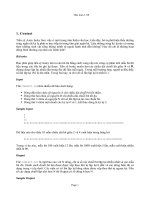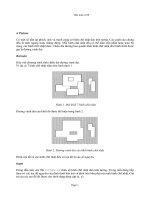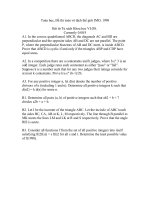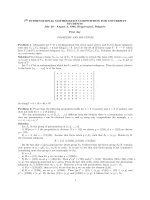D2835 89(reapproved 1998)
Bạn đang xem bản rút gọn của tài liệu. Xem và tải ngay bản đầy đủ của tài liệu tại đây (25.78 KB, 3 trang )
Designation: D 2835 – 89 (Reapproved 1998)
AMERICAN SOCIETY FOR TESTING AND MATERIALS
100 Barr Harbor Dr., West Conshohocken, PA 19428
Reprinted from the Annual Book of ASTM Standards. Copyright ASTM
Standard Specification for
Lubricant for Installation of Preformed Compression Seals
in Concrete Pavements1
This standard is issued under the fixed designation D 2835; the number immediately following the designation indicates the year of
original adoption or, in the case of revision, the year of last revision. A number in parentheses indicates the year of last reapproval. A
superscript epsilon (e) indicates an editorial change since the last revision or reapproval.
This standard has been approved for use by agencies of the Department of Defense.
4.2 Solids Content— The nonvolatile content of the lubricant shall be no less than 24.0 weight %.
4.3 Consistency— The lubricant shall exhibit a viscosity in
one of the following ranges:
4.3.1 Type I—for hand or machine application, 3000 to
8000 cP.
4.3.2 Type II—for machine application, 8000 to 15 000 cP.
4.4 Drying Rate— A bond between lubricant-coated papers
prepared after 8-min drying time shall separate completely in
less than 10 s when a 50-g load is applied in shear. A similar
bond prepared after 20-min drying time shall remain unseparated for a minimum of 10 s when a 50-g load is applied in
shear.
1. Scope *
1.1 This specification covers a lubricant suitable for facilitating the insertion and positioning of preformed elastomeric
compression seals in prepared voids (usually contraction
joints) in concrete pavement. For changes to this Standard
since the last issue, refer to the Summary of Changes Section
at the end of the Standard.
1.2 The requirements of the lubricant are based on the
performance of the lubricant as measured by its solids content,
homogeneity, consistency and drying rate.
1.3 The values stated in inch-pound units are to be regarded
as the standard. The metric equivalents of U.S customary units
may be approximate.
1.4 The following precautionary caveat pertains only to the
test method portion, Section 7 of this specification. This
standard does not purport to address all of the safety concerns,
if any, associated with its use. It is the responsibility of the user
of this standard to establish appropriate safety and health
practices and determine the applicability of regulatory limitations prior to use.
5. Basis of Purchase
5.1 Each lot of lubricant shall be accompanied by the
manufacturer’s certified test results attesting compliance with
this specification, unless an alternative agreement is concluded
by the manufacturer and the purchaser.
6. Sampling
6.1 The lubricant samples shall be a 1-quart (1-litre) aliquot
consisting of a composite taken when possible from three or
more separate containers chosen at random. Samples also shall
be taken from containers which appear to be nonrepresentative
and shall be tested separately. Before a sample is withdrawn,
the contents in the container shall be mixed to uniform
consistency. The sample shall be placed immediately in an
airtight-glass jar or metal can until tested.
2. Referenced Documents
2.1 ASTM Standards:
D 1084 Test Methods for Viscosity of Adhesives2
D 1644 Test Methods for Nonvolatile Content of Varnishes3
3. Classification
3.1 The lubricant shall be based on polychloroprene, containing only soluble phenolic resins blended together with
antioxidants and acid acceptors in a suitable mixture of organic
solvents.
7. Test Methods
7.1 Homogeneity— Stir the test sample by hand for 2 min
with a spatula. Withdraw the spatula and examine the lubricant
as it flows from the spatula for lumps or agglomerates.
Particles smaller in diameter than 0.015 in. (0.38 mm) shall not
be considered cause for rejection.
4. Requirements
4.1 Homogeneity— The lubricant shall be uniform and
contain no lumps or agglomerates.
NOTE 1—At the consumer’s request, compliance with the 0.015-in.
(0.38-mm) requirement shall be determined by a sample diluted 1 + 4 with
Xylene through a 40-mesh sieve.
1
This specification is under the jurisdiction of ASTM Committee D-4 on Road
and Paving Materials and is the direct responsibility of Subcommittee D04.34 on
Preformed Joint Fillers and Sealers.
Current edition approved Oct. 27, 1989. Published March 1990. Originally
published as D 2835 – 69 T. Last previous edition D 2835 – 72 (1982).
2
Annual Book of ASTM Standards, Vol 15.06.
3
Annual Book of ASTM Standards, Vol 06.01.
7.2 Solids Content— Determine in accordance with Method
A of Test Methods D 1644.
7.3 Consistency— Determine in accordance with Method B
*A Summary of Changes section appears at the end of this standard.
1
D 2835
by 2-in. aluminum plate over the bond area, and placing a 500
g laboratory weight on this plate for 10 s. Hang the bonded
pieces immediately in a vertical position and attach a 50-g
weight with a small loop of wire, weighing less than 1 g, to the
lower piece of paperboard forming the bond. Align the point of
support and the point of attachment for the weight on the center
lines of the cast films.
7.4.2.3 Record the time needed for the 50-g load to completely separate the bonded pieces with the aid of a stop watch.
If separation is not complete in 1 min, discontinue the test and
record the separation time as more than 1 min.
7.4.2.4 Repeat the above procedure with a pair of cast films
which are allowed to dry for 20 min before forming a bond.
7.4.2.5 Testing should be conducted at 73.4 6 3.6°F (23 6
1°C) and at a relative humidity of 50 6 5 %.
of Test Methods D 1084. Use a No. 4 spindle at 20 rpm at a test
temperature of 77 6 0.9°F (25 6 0.5°C).
7.4 Drying Rate:
7.4.1 Apparatus:
7.4.1.1 Film Applicator4, 2-in. (50-mm) wide, 5 to 25-mils
(0.127 to 0.635-mm) clearance set at 14 mils (0.356 mm).
7.4.1.2 Nonabsorbent Stiff Paper Surface5, 31⁄2by 6-in. (100
by 150-mm).
7.4.1.3 Brush-Out Panels5.
7.4.1.4 Stop Watch.
7.4.1.5 Wire.
7.4.1.6 Weights, 50-g, and 500-g.
7.4.1.7 Aluminum Plate, 1⁄8 by 1 by 2-in. (3 by 25 by
50-mm).
7.4.2 Procedure:
7.4.2.1 Condition the lubricant for at least 3 h at 73.46
3.6°F (23 6 2°C). Apply a series of 2 in. wide (wet thickness)
(14 6 2.5-mils) 0.356 6 0.064-mm films of the lubricant to
four separate nonabsorbent paper surfaces. A film applicator as
specified in 7.4.1.1 has been found to produce a wet film in the
specified range with this class of materials, but the deposited
film thickness from any specific spreader and lubricant system
should be checked to determine the conformance to the
specified thickness. Films should be at least 4 in. (100 mm)
long, centered on the paper and parallel to the long axis of the
sheet. Allow to dry in a horizontal position in a draft-free area.
The time upon completion of the casting of the second film of
each pair cast is recorded as the initial drying time for that pair
of films.
7.4.2.2 After several minutes drying, cut off at least 11⁄2 in.
(40 mm) from the bottom of the cast films and discard. After
drying 8 min overlap the cut edges of the first pair 1 in. and
place face-to-face to form a 1 by 2-in. area lap shear bond.
Take care to align the two films so that a force applied along
their center lines will impose a direct shear force without a
twisting movement. Form the bond by placing the overlapped
papers on a horizontal smooth surface, placing a 1⁄8-in. thick, 1
8. Precision and Bias
8.1 No statement is made about either the precision or bias
of the Test Method in Specification D 2835 for measuring
Homogeneity and Drying Rate, since the result merely states
whether there is conformance to the criteria for success
specificed in the procedure.
9. Packaging and Package Marking
9.1 Packaging—The material shall be packaged in standard
commercial containers, so constructed as to ensure acceptance
by common or other carrier for safe transportation at the lowest
rate to the point of delivery, unless otherwise specified in the
contract or order.
9.2 Marking—Shipping containers shall be marked with the
following information:
9.2.1 Manufacturer’s name or trademark, product code, and
batch or lot number,
9.2.2 Date of manufacture and recommended time limit of
storage before use,
9.2.3 Weight per gallon of lubricant to the nearest 1⁄10 lb
(0.05 kg)/gal,
9.2.4 Special handling instructions during product transfer,
and
9.2.5 Special precautions required because of product toxicity, flammability, or other such information pertinent to the
proper storage and use of the product.
4
The Gardner Ultra Applicator, available from Gardner Laboratories, Inc., P.O.
Box 5728, Bethesda, MD, Catalog No. Ag 3816J, has been found suitable for this
purpose.
5
Available from the Morest Co., Inc., 211 Center St., New York, NY 10013.
SUMMARY OF CHANGES
(3) The 10-g weight was deleted from 7.4.1.6.
(4) The temperature range was broadened in 7.4.2.1 and
7.4.2.5.
(5) The 4th sentence in Section 7.4.2.2 was revised to correct
an omission in the previous published issues.
(6) Section 8 on Precision and Bias was added.
This section identifies the location of changes to this standard
which have been incorporated since the last issue. The Technical Committee has highlighted those changes that affect the
technical interpretation or use of this standard.
(1) Section 1.2 was revised to delete “resistance to aging”.
(2) Section 1.3 was added and the following section renumbered.
2
D 2835
The American Society for Testing and Materials takes no position respecting the validity of any patent rights asserted in connection
with any item mentioned in this standard. Users of this standard are expressly advised that determination of the validity of any such
patent rights, and the risk of infringement of such rights, are entirely their own responsibility.
This standard is subject to revision at any time by the responsible technical committee and must be reviewed every five years and
if not revised, either reapproved or withdrawn. Your comments are invited either for revision of this standard or for additional standards
and should be addressed to ASTM Headquarters. Your comments will receive careful consideration at a meeting of the responsible
technical committee, which you may attend. If you feel that your comments have not received a fair hearing you should make your
views known to the ASTM Committee on Standards, 100 Barr Harbor Drive, West Conshohocken, PA 19428.
3









